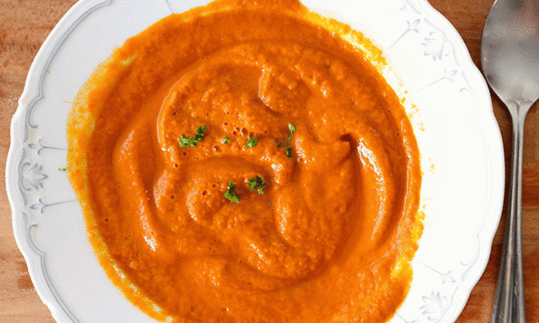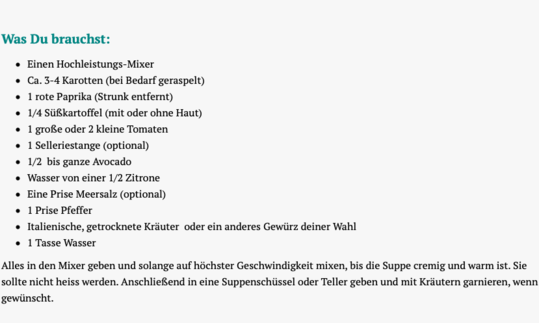Raw vegan pepper-carrot soup with Italian herbs
raw-vegan
Ingredients (for servings, )
| 3 ½ | Carrots (carrots), raw (organic?) (7.5 oz) |
| 1 | Sweet peppers, red, raw (organic?) (5.8 oz) |
| ½ | Sweet potato, raw (sweet potato, white potato) (2.3 oz) |
| 2 | Tomatoes, raw (organic?) (8.6 oz) |
| 1 stalk | Celery (bleached celery), raw (organic?) (1.1 oz) |
| ½ | Avocados, raw (organic?) (3.5 oz) |
| ½ | Lemons, raw (limes, organic?) (1.0 oz) |
| 1 dash | Sea salt (raw?, organic?) (0.01 oz) |
| 1 dash | Black pepper (organic?, raw?) (0.00 oz) |
| ½ tsp | Oregano, dried (raw?, organic?) (0.02 oz) |
| ½ tsp, ground | Thyme, dried, raw?, organic? (0.02 oz) |
| 250 ml | Drinking water, raw (organic?) (8.8 oz) |
Equipment
- blender
- grater
- citrus juicer (lemon squeezer)
Type of preparation
- chop or grind
- food preparation without heating
- blend
- squeeze
- grate (shred)
Preparation
Preparation
Clean the carrots and grate them if necessary. Remove the stalk and seeds from the pepper and clean them as well as the sweet potato, tomatoes and celery. Peel the avocado and remove the stone.
Squeeze the juice of half a lemon.The author recommends 3-4 carrots, 1 large or 2 small tomatoes and half to one whole avocado for 2 portions. You can also remove the skin from the sweet potato.
Finishing the soup
Place all ingredients in a blender along with salt (optional), pepper, Italian herbs and water and blend at high speed until the soup is creamy and warm, but not hot.We chose oregano and thyme as Italian herbs. Decide for yourself.
You can add more or less water to make the soup more liquid or creamy, depending on your preference.
serving
Pour the finished soup into a soup bowl or a (preheated) plate and garnish with herbs if desired.
|
Nutritional Information per person
Convert per 100g
|
2000 kcal | |
|---|---|---|
| Energy | 208 kcal | 10.4% |
| Fat/Lipids | 8.2 g | 11.8% |
| Saturated Fats | 1.2 g | 6.0% |
| Carbohydrates (inc.dietary fiber) | 33 g | 12.2% |
| Sugars | 14 g | 15.6% |
| Fiber | 11 g | 45.7% |
| Protein/Albumin | 4.7 g | 9.4% |
| Cooking Salt (Na:188.5 mg) | 479 mg | 20.0% |
| Essential micronutrients with the highest proportions | per person | 2000 kcal | |
|---|---|---|---|
| Vit | Vitamin C (ascorbic acid) | 142 mg | 177.0% |
| Vit | Vitamin A, as RAE | 1'310 µg | 164.0% |
| Vit | Vitamin K | 51 µg | 68.0% |
| Vit | Vitamin B9, B11 (Folate, as the active form of folic acid) | 129 µg | 65.0% |
| Elem | Potassium, K | 1'225 mg | 61.0% |
| Vit | Vitamin B6 (pyridoxine) | 0.71 mg | 51.0% |
| Prot | Threonine (Thr, T, irreversibly transaminated) | 0.34 g | 36.0% |
| Vit | Vitamin E, as a-TEs | 3.9 mg | 33.0% |
| Min | Copper, Cu | 0.31 mg | 31.0% |
| Min | Manganese, Mn | 0.61 mg | 30.0% |
Detailed Nutritional Information per Person for this Recipe
The majority of the nutritional information comes from the USDA (US Department of Agriculture). This means that the information for natural products is often incomplete or only given within broader categories, whereas in most cases products made from these have more complete information displayed.
If we take flaxseed, for example, the important essential amino acid ALA (omega-3) is only included in an overarching category whereas for flaxseed oil ALA is listed specifically. In time, we will be able to change this, but it will require a lot of work. An “i” appears behind ingredients that have been adjusted and an explanation appears when you hover over this symbol.
For Erb Muesli, the original calculations resulted in 48 % of the daily requirement of ALA — but with the correction, we see that the muesli actually covers >100 % of the necessary recommendation for the omega-3 fatty acid ALA. Our goal is to eventually be able to compare the nutritional value of our recipes with those that are used in conventional western lifestyles.
| Essential fatty acids | per person | 2000 kcal |
|---|---|---|
| Linoleic acid; LA; 18:2 omega-6 | 1.1 g | 11.0% |
| Alpha-Linolenic acid; ALA; 18:3 omega-3 | 0.09 g | 5.0% |
| Essential amino acids | per person | 2000 kcal |
|---|---|---|
| Threonine (Thr, T, irreversibly transaminated) | 0.34 g | 36.0% |
| Tryptophan (Trp, W) | 0.06 g | 22.0% |
| Isoleucine (Ile, I) | 0.19 g | 15.0% |
| Lysine (Lys, K, irreversibly transaminated) | 0.26 g | 14.0% |
| Phenylalanine (Phe, F) | 0.22 g | 14.0% |
| Valin (Val, V) | 0.21 g | 13.0% |
| Leucine (Leu, L) | 0.28 g | 12.0% |
| Methionine (Met, M) | 0.06 g | 7.0% |
| Vitamins | per person | 2000 kcal |
|---|---|---|
| Vitamin C (ascorbic acid) | 142 mg | 177.0% |
| Vitamin A, as RAE | 1'310 µg | 164.0% |
| Vitamin K | 51 µg | 68.0% |
| Vitamin B9, B11 (Folate, as the active form of folic acid) | 129 µg | 65.0% |
| Vitamin B6 (pyridoxine) | 0.71 mg | 51.0% |
| Vitamin E, as a-TEs | 3.9 mg | 33.0% |
| Vitamin B5 (Pantothenic acid) | 1.7 mg | 28.0% |
| Vitamin B7 (Biotin, ex vitamin H) | 13 µg | 26.0% |
| Vitamin B3 (Niacin) | 3.7 mg | 23.0% |
| Vitamin B1 (Thiamine) | 0.23 mg | 21.0% |
| Vitamin B2 (Riboflavin) | 0.25 mg | 18.0% |
| Essential macroelements (macronutrients) | per person | 2000 kcal |
|---|---|---|
| Potassium, K | 1'225 mg | 61.0% |
| Sodium, Na | 189 mg | 24.0% |
| Phosphorus, P | 137 mg | 20.0% |
| Magnesium, Mg | 65 mg | 17.0% |
| Calcium, Ca | 93 mg | 12.0% |
| Essential trace elements (micronutrients) | per person | 2000 kcal |
|---|---|---|
| Copper, Cu | 0.31 mg | 31.0% |
| Manganese, Mn | 0.61 mg | 30.0% |
| Iron, Fe | 2.1 mg | 15.0% |
| Zinc, Zn | 1.2 mg | 12.0% |
| Iod, I (Jod, J) | 5.9 µg | 4.0% |
| Fluorine, F | 100 µg | 3.0% |
| Selenium, Se | 0.73 µg | 1.0% |
The warm raw vegan pepper and carrot soup with Italian herbs is prepared in a flash and is particularly rich in vitamins A and C.
Nutrient profile: According to GDA guidelines, one portion of this soup covers about 1 ½ times the average daily requirement of vitamin A and vitamin C. Furthermore, it covers over 50% of the daily requirement of vitamin K, potassium and folic acid.
Carrots and vitamin A: Carrots are one of the low-calorie vegetables. They are particularly rich in carotene, a precursor to vitamin A, which gives them their typical orange color. Vitamin A is important for our eyesight, among other things, but also for the immune system.
When preparing carrots, it is helpful to add a little fat to the dish, as this helps our body absorb the fat-soluble carotene better. However, chewing the carrots well has a greater impact than adding oil.
Sweet peppers: The most commonly used variety of pepper in Europe and the USA is the sweet pepper ( Capsicum annuum). Most varieties change color from green to red, yellow or orange during the ripening process, depending on the carotenoids present. This is because chlorophyll, the green leaf pigment that is crucial for photosynthesis, decreases while the colored carotenoid pigments appear. Green peppers therefore often have a more pronounced flavor than ripe red and yellow peppers, although the latter tend to taste a little sweeter.
Celery: Celery, also known as celery sticks, is a variety of real celery. It has a mild celery taste but a fresh, juicy and crunchy consistency. Thanks to its high water content, it is one of the lowest-calorie vegetables. Its typical smell is due to essential oils that are found in so-called oil ducts. Celery also contains antioxidant vitamins such as vitamin C or beta-carotene and many polyphenols (secondary plant substances) that slow down or completely prevent oxidation processes.
Avocados: Avocados have a higher fat content than any other known fruit and vegetable. They are also rich in potassium and unsaturated fatty acids. They are best eaten raw, as long as the flesh is not brown or grayish. For information on preventing browning and storage, see Tips.
Tomatoes: The tomato consists of approximately 95% water and mainly contains vitamins A, B1, B2, C, E, niacin, secondary plant substances and minerals (especially potassium) and trace elements. The skin of the tomato contains polysaccharides, cutin, hydrocarbons and fatty acids and contains flavonoids.
Purchasing and storing celery: Fresh celery is pale white to light green in color. Medium-sized specimens are preferable because their fibers are not as pronounced. Fresh celery sticks cannot be bent; they break immediately. You can store fresh celery in the vegetable compartment of your refrigerator. However, according to new studies, celery should be consumed within 5-7 days because after that the effectiveness of its antioxidants decreases.
Preventing avocados from turning brown: Cutting the avocados causes a break in the affected cell walls, which exposes the escaping ingredients to the oxidation process. This in turn causes the flesh to turn brown. Drizzling lemon or lime juice can prevent this and also goes well with the raw vegan dish.
Storage of avocados: Avocados are harvested when they are unripe. To ripen them, it is best to place avocados next to apples (or put them together in a paper bag) and store them at room temperature. The apple emits the gas ethylene, which promotes ripening.
Raw soups are quick to prepare and important nutrients such as enzymes, valuable amino acids or secondary plant substances are retained. From around 43 °C, these essential nutrients gradually break down due to the heat. Therefore, raw soups should only be warmed slightly in a blender. A high-performance blender is recommended for preparing raw soups. It not only ensures a creamy consistency, but it also heats the soup quite quickly due to the fast rotation.
Seasoning and consistency: The character of the soup changes depending on which herbs you use for seasoning. You can also add more or less water to make the soup more liquid or creamy.





